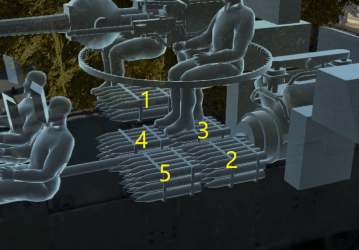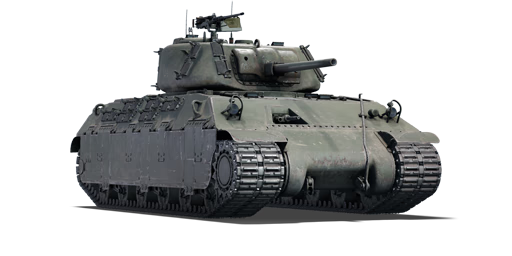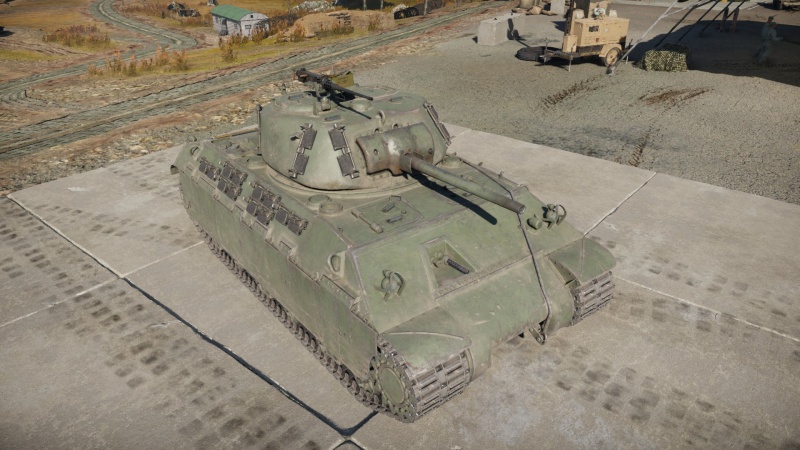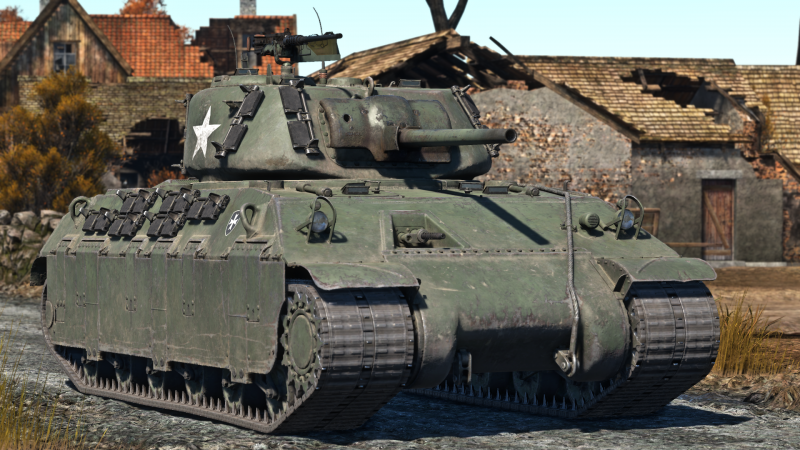Difference between revisions of "T14"
m |
panda_giyu (talk | contribs) (→Survivability and armour) (Tag: Visual edit) |
||
| Line 14: | Line 14: | ||
{{Specs-Tank-Armour}} | {{Specs-Tank-Armour}} | ||
<!-- ''Describe armour protection. Note the most well protected and key weak areas. Appreciate the layout of modules as well as the number and location of crew members. Is the level of armour protection sufficient, is the placement of modules helpful for survival in combat? If necessary use a visual template to indicate the most secure and weak zones of the armour.'' --> | <!-- ''Describe armour protection. Note the most well protected and key weak areas. Appreciate the layout of modules as well as the number and location of crew members. Is the level of armour protection sufficient, is the placement of modules helpful for survival in combat? If necessary use a visual template to indicate the most secure and weak zones of the armour.'' --> | ||
| − | + | Although classified as a heavy tank, the T14's armor may not initially impress when compared to the anti-tank weaponry prevalent in its battle rating bracket. Despite its relatively thin armor for a heavy tank, the T14 compensates with a pronounced slope effect, particularly evident in its turret. Understanding this armor profile is crucial for maintaining battlefield advantage. | |
| − | When | + | When engaging a T14 head-on, targeting the lower glacis can yield effective results, damaging its transmission and potentially immobilizing it, facilitating flanking maneuvers. If the T14 adopts an angled position, utilizing smoke can be a tactical advantage. Deploy smoke shells directly at or ahead of the tank, then maneuver accordingly. Due to the T14's characteristics, it may advance through the smoke, unknowingly exposing itself to point-blank penetration. |
| − | The T14 heavy tank | + | The T14 heavy tank boasts commendable survivability, thanks to its robust frontal and side armor, along with a resilient turret. However, it's important to note the vulnerability of the turret cheek, susceptible to penetration by most tanks within its battle rating range. In lower-tier matches, the T14 excels as a breakthrough tank, leading assaults against enemy positions. Nevertheless, in higher-tier battles, its armor becomes less dependable against adversaries with superior penetrating capabilities, such as the German 88 mm or the Soviet 85 mm cannons. |
| − | + | Similar to the Sherman, the T14 features a vulnerable machine gun port, emphasizing caution when negotiating corners to avoid exposure. | |
'''Armour type:''' | '''Armour type:''' | ||
Revision as of 17:48, 16 April 2024
Contents
Description
The Assault Tank T14 was a cooperative project between the U.S. Army and the British Army to develop a universal infantry tank. The Assault Tank T14 project was never completed because the prototype was not sent to the UK until 1944, by which time the Churchill infantry tanks had been in service for two years and had substantially improved from their initial prototype. The Medium Tank T20 is the result of U.S. efforts to develop a similarly armoured tank with a higher speed for use other than infantry support. Only two prototypes were produced, one for testing in the U.S. and the other for testing in Britain. The tank transported to Britain is still on display at the tank museum in Bovington. The British had built the Heavy Assault Tank A33 "Excelsior" design to the same specifications as the Assault Tank T14, but it was never deployed.
Introduced in Update 1.67 "Assault", the Assault Tank T14 is designed to break through powerful enemy defences. Its 75 mm M3 tank gun reloads quickly, and its armour is strong enough to withstand numerous hits. With its primitive vertical stabilizer, it can also fire while moving and make fast stops around corners to attack the opponent. Its front armour is greatly slanted at 61°. Side-top armour is also sloped at 30°, and since it is the same thickness as the front, it is easy to angle without fear of revealing weak points. The lower side armour is not sloped, although it is thicker than the top and front to guard against glancing shots. Players will be delighted to experience this special heavy tank and lead the charge during battles.
General info
Survivability and armour
Although classified as a heavy tank, the T14's armor may not initially impress when compared to the anti-tank weaponry prevalent in its battle rating bracket. Despite its relatively thin armor for a heavy tank, the T14 compensates with a pronounced slope effect, particularly evident in its turret. Understanding this armor profile is crucial for maintaining battlefield advantage.
When engaging a T14 head-on, targeting the lower glacis can yield effective results, damaging its transmission and potentially immobilizing it, facilitating flanking maneuvers. If the T14 adopts an angled position, utilizing smoke can be a tactical advantage. Deploy smoke shells directly at or ahead of the tank, then maneuver accordingly. Due to the T14's characteristics, it may advance through the smoke, unknowingly exposing itself to point-blank penetration.
The T14 heavy tank boasts commendable survivability, thanks to its robust frontal and side armor, along with a resilient turret. However, it's important to note the vulnerability of the turret cheek, susceptible to penetration by most tanks within its battle rating range. In lower-tier matches, the T14 excels as a breakthrough tank, leading assaults against enemy positions. Nevertheless, in higher-tier battles, its armor becomes less dependable against adversaries with superior penetrating capabilities, such as the German 88 mm or the Soviet 85 mm cannons.
Similar to the Sherman, the T14 features a vulnerable machine gun port, emphasizing caution when negotiating corners to avoid exposure.
Armour type:
- Rolled homogeneous armour
- Cast homogeneous armour (Turret, Transmission cover, Gun mantlet)
| Armour | Front (Slope angle) | Sides | Rear | Roof |
|---|---|---|---|---|
| Hull | 50 mm (61°) Front Glacis 50-101.6 mm (11-57°) Transmission cover 50-70 mm (11°) Machine gun port |
50 mm (30°) Top 63.5 + 12.7-25.4 mm Bottom |
50 mm (19°) Upper 50 mm (21°) Lower |
25.4 mm |
| Turret | 76.2 mm (30-31°) Turret front 50.8 + 88 mm (1-62°) Gun mantlet |
101.6 mm (3-53°) | 101.6 mm (0-25°) Rear | 25.4 mm |
| Cupola | 51 mm | 51 mm | 51 mm | 25.4 mm |
Notes:
- Suspension wheels are 15 mm thick, bogies are 10 mm thick, while tracks are 20 mm thick.
- Tracks are peppered on the sides that give 20 mm extra where they are.
- Belly armour is 25.4 mm thick
Mobility
Despite being a heavy tank, the T14 is surprisingly mobile. The T14's mobility is comparable to most medium tanks, and it can easily surprise the enemy by reaching unexpected locations during the early stages of a match. It can quickly react to threats and be used as a brawling tank during a downtier thanks to its fast traversing turret and excellent turning ability.
| Game Mode | Max Speed (km/h) | Weight (tons) | Engine power (horsepower) | Power-to-weight ratio (hp/ton) | |||
|---|---|---|---|---|---|---|---|
| Forward | Reverse | Stock | Upgraded | Stock | Upgraded | ||
| Arcade | 41 | 6 | 42.6 | 646 | 954 | 15.16 | 22.39 |
| Realistic | 38 | 5 | 442 | 500 | 10.38 | 11.74 | |
Modifications and economy
Armaments
Main armament
| 75 mm M3 | Turret rotation speed (°/s) | Reloading rate (seconds) | |||||||||||
|---|---|---|---|---|---|---|---|---|---|---|---|---|---|
| Mode | Capacity | Vertical | Horizontal | Stabilizer | Stock | Upgraded | Full | Expert | Aced | Stock | Full | Expert | Aced |
| Arcade | 72 | -10°/+24° | ±180° | Vertical | 19.42 | 26.88 | 32.64 | 36.10 | 38.40 | 6.50 | 5.75 | 5.30 | 5.00 |
| Realistic | 14.28 | 16.80 | 20.40 | 22.56 | 24.00 | ||||||||
Ammunition
| Penetration statistics | |||||||
|---|---|---|---|---|---|---|---|
| Ammunition | Type of warhead |
Penetration @ 0° Angle of Attack (mm) | |||||
| 10 m | 100 m | 500 m | 1,000 m | 1,500 m | 2,000 m | ||
| M72 shot | AP | 91 | 88 | 78 | 67 | 57 | 49 |
| M48 shell | HE | 10 | 10 | 10 | 10 | 10 | 10 |
| M61 shot | APCBC | 104 | 102 | 93 | 84 | 75 | 68 |
| T45 shot | APCR | 139 | 135 | 121 | 105 | 91 | 79 |
| Shell details | ||||||||||||
|---|---|---|---|---|---|---|---|---|---|---|---|---|
| Ammunition | Type of warhead |
Velocity (m/s) |
Projectile mass (kg) |
Fuse delay (m) |
Fuse sensitivity (mm) |
Explosive mass (TNT equivalent) (g) |
Ricochet | |||||
| 0% | 50% | 100% | ||||||||||
| M72 shot | AP | 619 | 6.3 | - | - | - | 47° | 60° | 65° | |||
| M48 shell | HE | 463 | 6.3 | 0.2 | 0.1 | 666 | 79° | 80° | 81° | |||
| M61 shot | APCBC | 618 | 6.79 | 1.2 | 14 | 63.7 | 48° | 63° | 71° | |||
| T45 shot | APCR | 868 | 3.81 | - | - | - | 66° | 70° | 72° | |||
| Smoke shell characteristics | ||||||
|---|---|---|---|---|---|---|
| Ammunition | Velocity (m/s) |
Projectile mass (kg) |
Screen radius (m) |
Screen deploy time (s) |
Screen hold time (s) |
Explosive mass (TNT equivalent) (g) |
| M89 | 259 | 3 | 9 | 5 | 20 | 50 |
Ammo racks

| Full ammo |
1st rack empty |
2nd rack empty |
3rd rack empty |
4th rack empty |
5th rack empty |
Visual discrepancy |
|---|---|---|---|---|---|---|
| 72 | 61 (+11) | 46 (+26) | 31 (+41) | 16 (+56) | 1 (+71) | No |
Machine guns
| 12.7 mm M2HB | ||||
|---|---|---|---|---|
| Mount | Capacity (Belt) | Fire rate | Vertical | Horizontal |
| Pintle | 600 (200) | 577 | -10°/+15° | ±60° |
| 7.62 mm M1919A4 | ||||
|---|---|---|---|---|
| Mount | Capacity (Belt) | Fire rate | Vertical | Horizontal |
| Coaxial | 3,000 (250) | 500 | N/A | N/A |
Usage in battles
This is an assault tank, and therefore a brawler. Its 75 mm gun has a quick reload and the armour is good enough to bounce most shots. With its stabilizer, it also allows for fire-on-the-move and perform short stops around corners to blast the enemy. The APHE shells decimate Panzer IIIs and Panzer IVs, but if not angled the Panzer IV will go straight through the upper glacis plate and do the same to the T14.
The T14 is a boxy tank, so sidescraping is a valid tactics around corners. Ensure that the T14 maintains a 45 degree angle towards the enemy/target. Example: if advancing down the street in places like Advance to the Rhine, it's best to drive across the road in a 45 degree angle to bounce shots. Go slowly enough and the stabilizer can be utilized to return fire while on the move, forcing the enemy to withdraw from its position. Try not to expose the side armour in any case as it may lead to giving the enemy an opportunity to penetrate the armour.
On a further note, the T14s 75 mm can use up its ammo rather quickly, so be wary of the ammo count and be prepared to go back to the cap zones to rearm.
This tank is slow off the mark, but once moving it is quite quick. The turn rate is slow at low speeds, so try and build up speed before turning. This is worth remembering when sidescraping. Because the T14 has APHE and APCR, it can punch through most opposing armour, including the drivers view port on the KV-1. With APHE, if aiming at Soviet tanks like the T-34, aim at the turret cheeks and it will go through, or the drivers hatch or machine gun port for some lovely ammo cook offs. For the Germans, aim at lower glacis or the MG gunners position and it will hopefully knock out all the crew.
Pros and cons
Pros:
- Good ol' tried 75 mm gun
- Access to APCR ammunition for an extra punch
- Front armour is heavily sloped
- Side armour is rather thick, allowing it to angle a lot for deflecting more shells, even the 76 mm M1
- Good mobility
- Not a commonly encountered tank. Players may hesitate while they work out where to shoot
Cons:
- Base armour is only 50-70 mm thick
- Hull machine gun port is a prominent weak spot
- Thin turret front armour
- 75 mm gun may have trouble dealing with heavily armoured enemies, even with APCR
History
Development
In early 1942, a conference between United States Tank Committee and Joint British Tank Mission had the British propose the need of an assault tank.[1] The assault tank, a designation reserved by the British at the time that was distinctive from their cruiser and infantry tanks, was not taken up by the US. However, the US agreed to a prototype production plan in which a vehicle design would be produced by both nations, and a limited production would be established for the better of the two. On 30 March 1942[2], the final details were placed with Aberdeen instructed to start designing a vehicle and a wooden mock-up, and the British also working on their vehicle based off the Cromwell chassis, which would become the A.33 Excelsior. The British set the estimated production scale for the assault tank to be 8,500 units.[1] In May 1942, the details were finalized and a designation was chosen for the vehicle, T14.
In June, the design and wooden mock-up was established and the production order for two Assault Tank T14 went to the American Locomotive Company.[2] The tanks were produced in July and August 1943 for each unit. These two tanks would only be different except in their hydraulic power traverse, in which one used a Westinghouse model and the other had an Oilgear model. Which of the two tanks had which traverse model is not known.
Testing and cancellation
The two T14 were sent off for testing, the first model sent to Fort Knox and the second was sent to Britain.[2] The Fort Knox tests showed a variety of problems in the design such as fume seeping into the crew compartment, cramped conditions, suspension problems, inaccessible components, and the bow machine gun tendency of breaking the operator's arm.[3] The T14 also had a tendency for the tracks to be thrown and the overall tank was not very mobile with an underpowered Ford GAZ engine propelling the 47 ton tank.[2] Regardless, the T14 eventually fell out of favor for the same reason the Excelsior did. The British had their Churchill infantry tank become more favorable to their armoured doctrine as the assault tank they needed. Due to the lack of interest, the T14 program was cancelled. Today, only one T14 tank remained intact at the Bovington Tank Museum, stored away in their storage hall.
The assault tank concept did not die with the failure of the two designs. The Churchill fitted this role well in the British armoured force as an infantry tank and the Americans eventually produced simpler version of it as the M4A3E2 Jumbo.
Media
- Skins
- Videos
See also
Links to the articles on the War Thunder Wiki that you think will be useful for the reader, for example:
- reference to the series of the vehicles;
- links to approximate analogues of other nations and research trees.
External links
References
- ↑ 1.0 1.1 Moran, Nicholas "The Chieftain's Hatch: British Assault Tank" World of Tanks. N.p., 02 Aug. 2013. Web. 05 Nov 2017. Website
- ↑ 2.0 2.1 2.2 2.3 Jeeps_Guns_Tanks. "#33 The Sherman Of The Future: Advanced Sherman UpGrades That Almost Made It Into Production." The Sherman Tank Site. WordPress, 12 Dec. 2015. Web. 22 May 2017. Website
- ↑ Moran, Nicholas "Design and History of the M4 Sherman Tank During World War II (43:00 - 43:52)" C-SPAN. 22 Sept. 2017. Web. 05 Nov. 2017. Video
| USA heavy tanks | |
|---|---|
| M4 Jumbo | M4A3E2 · Cobra King · M4A3E2 (76) W |
| M6 | M6A1 · T1E1 · T1E1 (90) · M6A2E1 |
| T26 | T26E1-1 · T26E5 |
| T29/30/34 | T29 · T30 · T34 |
| T32 | T32 · T32E1 |
| M103 | M103 |
| Others | T14 |
| USA premium ground vehicles | |
|---|---|
| Light tanks | LVT(A)(4) · M2A4 (1st Arm.Div.) · M3A1 (USMC) · ▃Stuart VI (5th CAD) · M8 LAC · M8A1 GMC |
| M18 "Black Cat" · Super Hellcat · T18E2 · M551(76) · T114 · M1128 Wolfpack | |
| Medium tanks | ▃Grant I · M4A5 · Calliope · T20 · M26 T99 · M26E1 · M46 "Tiger" · T54E1 · T54E2 · ▃Magach 3 (ERA) · M728 CEV |
| XM1 (GM) · XM1 (Chrysler) · M1 KVT · M1A1 Click-Bait | |
| Heavy tanks | T14 · Cobra King · M6A2E1 · T29 · T30 |
| Tank destroyers | T28 · T55E1 |






